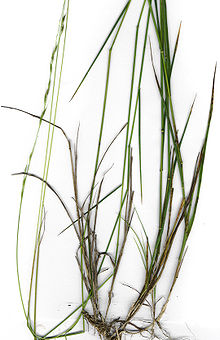- Microlaena stipoides
-
Microlaena stipoides 
Microlaena stipoides Scientific classification Kingdom: Plantae (unranked): Angiosperms (unranked): Monocots (unranked): Commelinids Order: Poales Family: Poaceae Genus: Microlaena Species: M. stipoides Binomial name Microlaena stipoides Microlaena stipoides or Ehrharta stipoides, is a species of grass that occurs naturally in all states of Australia as well as in New Zealand, Papua New Guinea, Indonesia and the Philippines.[1][2] It has also been introduced into Hawaii and Reunion Island and has been reported as invasive in both.[2][3] Common names used include weeping grass, weeping rice grass and weeping meadow grass.[4]
P. Martin, writing in 2004, commented:[5] “Although the generic name Microlaena is strongly defended by Australasian agrostologists (e.g. Wheeler et al. 2002) many European authors treat it as a section of the genus Ehrharta, so that information on the species in question will be found in these sources under the name Ehrharta stipoides Labill. (e.g. Clayton and Renvoize 1986).” He chooses to refer to the species as Microlaena stipoides throughout the rest of his paper. The Australian Plant Census lists both names as synonymous,[6] but a search for the common name, “weeping grass” in the Australian Botanic Garden’s database yields the name “Microlaena stipoides”.[7] This name will be used for the rest of the article. Not all species are affected by this ambiguity. The non-indigenous species Ehrharta erecta, for example, remains in the genus Ehrharta in the literature of Oceania and the western Pacific.[7]
Description
Microlaena stipoides grows to a height of approximately 0.7 metres and produces delicate drooping stalks carrying the spikelets which contain seeds.[1] The naked caryopses (grains) are similar in shape to rice grains but smaller, approximately 5 mm long, with a mass that varies widely, ranging from 1 mg to 7 mg.[3][4][8] Microlaena stipoides prefers acidic soils and is drought- and frost-tolerant.[9] In Australia it is found in areas of medium to high rainfall (above 600 mm per annum) and the leaves normally remain green all year.[10]
Uses
Microlaena stipoides produces nutritious pasture for grazing livestock with productivity of approximately 2-7 tonnes per hectare and digestibility of approximately 60-70%.[8][9][11] Its drought-tolerant qualities have led to an increasing interest in its use for turf to replace exotic species and research is being conducted into its potential for development as perennial grain crop.[4][5][12][13] The grains are high in protein and small-scale commercial production for human consumption has commenced.[10]
References
- ^ a b PlantNET - FloraOnline NSW Royal Botanic Gardens. Retrieved 2010-04-03.
- ^ a b Microlaena stipoides (PIER species info) Pacific Island Ecosystems at Risk, Hawaiian Ecosystems at Risk. Retrieved 2010-04-03.
- ^ a b PLANTS profile for Microlaena stipoides (weeping grass) | USDA PLANTS The site contains images of seeds. Retrieved 2010-04-03.
- ^ a b c C.L. Davies, D.L. Waugh and E.C. Lefroy "Variation in seed yield and its components in the Australian native grass Microlaena stipoides as a guide to its potential as a perennial grain crop." CSIRO PUBLISHING - Crop & Pasture Science. Retrieved 2010-04-03.
- ^ a b P.M. Martin, The potential of native grasses for the use of managed turf 4th International Crop Science Congress, 2004. Extensive further references. Retrieved 2010-04-03.
- ^ Australian Plant Census Retrieved 2010-04-03.
- ^ a b Common Names of Australian Plants Australian National Botanic Gardens. Retrieved 2010-04-03.
- ^ a b MicrolaenaStipoidesWeepingGrass.pdf Taroom Shire Council Land Care. Retrieved 2010-04-03.
- ^ a b Weeping grass or microlaena | NSW Department of Primary Industries Retrieved 2010-04-03.
- ^ a b CL Davies, DL Waugh and EC Lefroy "Perennial Grain Crops for High Water Use - The case for Microlaena stipoides" A report for the Rural Industries Research and Development Corporation, RIRDC Publication No 05/024, February 2005
- ^ DB Magcalemacandog and RDB Whalley "Distribution of Microlaena stipoides and Its Association With Introduced Perennial Grasses in a Permanent Pasture on the Northern Tablelands of New South Wales". CSIRO PUBLISHING - Australian Journal of Botany. Retrieved 2010-04-03.
- ^ Microlaena stipoides, a native grass/ Powerhouse Museum, Sydney, NSW, Australia. An image of the use of M. stipoides in a lawn. Retrieved 2010-04-03.
- ^ Malory, S, Henry, RJ, Shapter, FM & Chivers, I 2009 "Domestication of a wild relative of rice, Microlaena stipoides", paper presented to Plant Genomics and Beyond, Evry, France, 5–8 July. Research at Southern Cross University, NSW, Australia.
Categories:- Poaceae
- Flora of Indonesia
- Flora of New Zealand
- Flora of the Philippines
- Flora of New South Wales
- Flora of the Northern Territory
- Flora of Queensland
- Flora of South Australia
- Flora of Victoria (Australia)
- Flora of Tasmania
- Poales of Australia
- Angiosperms of Western Australia
Wikimedia Foundation. 2010.
